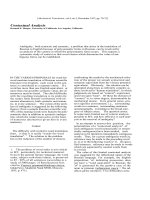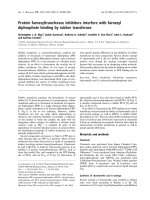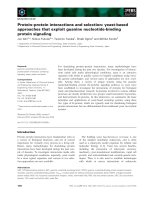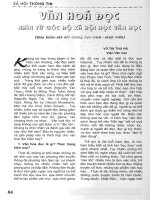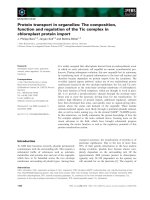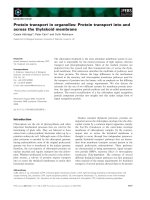Báo cáo khoa học: Protein lipidation doc
Bạn đang xem bản rút gọn của tài liệu. Xem và tải ngay bản đầy đủ của tài liệu tại đây (247.15 KB, 9 trang )
MINIREVIEW
Protein lipidation
Marissa J. Nadolski and Maurine E. Linder
Department of Cell Biology and Physiology, Washington University School of Medicine, St Louis, MO, USA
Introduction
Proteins are covalently modified with lipids through
multiple mechanisms. Lipid modifications can be
broadly divided into two categories: those that occur
in the cytoplasm or on the cytoplasmic face of mem-
branes, and those that occur in the lumen of the secre-
tory pathway. Three common lipid modifications that
occur in the cytoplasm are N-myristoylation, S-palmi-
toylation, and prenylation (Fig. 1). N-myristoylation is
the covalent addition of the fatty acid myristate to an
N-terminal glycine residue via an amide linkage [1].
Prenylation is the addition of an isoprenoid, either a
C15 farnesyl or a C20 geranylgeranyl group, to a
C-terminal cysteine residue via a thioether linkage [2].
Lastly, S-palmitoylation is the covalent addition of a
long-chain fatty acid to a cysteine residue via a thio-
ester linkage [3–5].
The best-characterized lipid modification that occurs
in the lumen of the secretory pathway is the attach-
ment of glycosylphosphatidylinositol (GPI) anchors
[6]. This lipid modification is composed of a phospha-
tidylinositol connected through a carbohydrate linker
to the protein. Following addition of the GPI moiety
in the endoplasmic reticulum (ER), the protein traffics
through the secretory pathway to the cell surface,
where the GPI anchor tethers the protein to the extra-
cellular face of the plasma membrane.
The secreted morphogens Hedgehog and Wnt have
recently gained attention as targets for lipid modifica-
tion [7]. Like GPI-anchored proteins, these proteins
receive their lipid modifications in the lumen of the
secretory pathway. Hedgehog is modified with both
cholesterol and palmitate. As the protein undergoes an
autoprocessing event that results in cleavage between
the glycine and cysteine residues of a GCF motif, a
cholesterol moiety is added to the now C-terminal gly-
cine residue of the N-terminal cleavage product
(Fig. 1). This same cleavage product is then N-palmi-
toylated on the cysteine at its extreme N-terminus
Keywords
DHHC-CRD; fatty acylation; myristoylation;
palmitoylation; prenylation; protein
acyltransferase; protein lipidation;
S-palmitoylation; Ras; ZDHHC
Correspondence
M. E. Linder, Box 8228, 660 S. Euclid,
St Louis, MO 63110, USA
Fax: +1 314 362 7463
Tel: +1 314 362 6040
E-mail:
(Received 30 April 2007, revised 20 July
2007, accepted 25 July 2007)
doi:10.1111/j.1742-4658.2007.06056.x
Proteins are covalently modified with a variety of lipids, including fatty
acids, isoprenoids, and cholesterol. Lipid modifications play important
roles in the localization and function of proteins. The focus of this review
is S-palmitoylation, the reversible addition of palmitate and other long-
chain fatty acids to proteins at cysteine residues in a variety of sequence
contexts. The functional consequences of palmitoylation are diverse. Palmi-
toylation facilitates the association of proteins with membranes, mediates
protein trafficking, and more recently has been appreciated as a regulator
of protein stability. Members of a family of integral membrane proteins
that harbor a DHHC cysteine-rich domain mediate most cellular palmitoy-
lation events. Here we focus on DHHC proteins that modify Ras proteins
in yeast and mammalian cells.
Abbreviations
CRD, cysteine-rich domain; DHHC-CRD, Asp-His-His-Cys cysteine-rich domain; eNOS, endothelial nitric oxide synthase; ER, endoplasmic
reticulum; GCP, Golgi complex protein; GFP, green fluorescent protein; GPI, glycosylphosphatidylinositol; PAT, protein acyltransferase;
TMD, transmembrane domain.
5202 FEBS Journal 274 (2007) 5202–5210 ª 2007 The Authors Journal compilation ª 2007 FEBS
(Fig. 1). The process of N-palmitoylation is postulated
to occur via a thioester intermediate utilizing the thiol
of the cysteine residue, followed by a spontaneous
rearrangement to form the amide linkage. Wnt, on the
other hand, is modified twice with acyl groups. The
first modification of Wnt to be discovered was S-palm-
itoylation. Murine Wnt-3a is S-palmitoylated at the
conserved cysteine 77. S-palmitoylation is not required
for secretion of the protein but is important for Wnt’s
ability to signal [8]. The second modification recently
discovered on Wnt-3a was O-acylation at serine 209.
Interestingly the acyl group identified by MS is palmi-
toleic acid (16:1), a monounsaturated fatty acid
(Fig. 1). As opposed to the S-palmitoylation, the
O-acylation of Wnt is associated with exit from the
ER and subsequent secretion [9].
The focus of this review will be S-palmitoylation,
hereafter referred to as palmitoylation, which occurs
on the cytoplasmic surface of membranes. Palmitoyla-
tion is unique among lipid modifications in that it is
reversible [3,4]. The regulation of palmitoylation status
is mediated by two classes of enzymes. Protein acyl-
transferases (PATs) are responsible for catalyzing the
addition of palmitate to the substrate, and protein
acylthioesterases are responsible for the removal of the
palmitate. A protein could therefore undergo several
rounds of palmitoylation and depalmitoylation during
its lifetime, either constitutively or in response to sig-
nals. In the remainder of this review, we will briefly
discuss the sequence context of the sites of palmitoyla-
tion and the role of palmitoylation in the function of
proteins. We will then discuss the enzymes responsible
for palmitoylation, including our own work on a PAT
that modifies mammalian Ras proteins.
Palmitoylated motifs
Myristoylation and prenylation have well-defined con-
sensus sequences. Myristoylation absolutely requires
an N-terminal glycine residue that is exposed upon
cleavage of the initiator methionine or generated by a
proteolytic cleavage event [10]. Prenylation occurs at a
C-terminal CaaX motif, where C represents a cysteine,
a is typically an aliphatic amino acid, and the identity
of amino acid X determines whether the protein will
be modified with a farnesyl or geranylgeranyl group.
Geranylgeranylation of proteins can also occur at
C-terminal CC or CXC motifs [2]. Palmitoylation, on
the other hand, has no single sequence requirement
outside of the presence of a cysteine residue. Despite
the absence of a universal palmitoylation motif, many
palmitoylated proteins can be categorized according to
the sequence context of their palmitoylation. To begin,
palmitoylated proteins can be subdivided into two cat-
egories: proteins synthesized on free ribosomes that
associate peripherally with membranes, and proteins
containing transmembrane domains (TMDs).
Palmitoylated proteins peripherally associated with
membranes can be further subdivided into dually lipi-
dated proteins and solely palmitoylated proteins [3].
Palmitoylation is often found adjacent to other lipid
modifications. This is a feature of numerous signal
transducers. G-protein a-subunits of the G
i
family and
many nonreceptor tyrosine kinases are palmitoylated at
one or more cysteines adjacent to the myristoylated
glycine, whereas N-Ras and H-Ras are palmitoylated at
one or two cysteines, respectively, adjacent to the farn-
esylation site. The sites of palmitoylation of proteins
exclusively modified with palmitate are found through-
out proteins, frequently at pairs or longer stretches of
cysteine residues in close proximity. Proteins with
TMDs are often modified at cysteine residues at the
interface of the cytoplasm and membrane or in cyto-
plasmic C-terminal tails.
Functions of palmitoylation
As the field of palmitoylation has advanced, it has
become clear that the roles of palmitoylation are
S-Palmitoylation
Farnesylation
N-Myristoylation
Modifying Group
Cholesterol
O-Acylation
N-Palmitoylation
Geranylgeranylation
Modification
O
S
O
N
H
O
O
O
N
H
O
O
N
H
S
S
Fig. 1. Structures of covalent lipid modifications.
M. J. Nadolski and M. E. Linder Function and mechanism of palmitoylation
FEBS Journal 274 (2007) 5202–5210 ª 2007 The Authors Journal compilation ª 2007 FEBS 5203
diverse. The most commonly described function of
palmitoylation is to increase the affinity of a soluble
protein for membranes, which can thereby affect the
protein’s localization and function. This is the case for
both solely palmitoylated proteins and dually lipidated
proteins. This raises the question of why a protein with
one lipid modification needs a second lipid modifica-
tion to associate with membranes. Biophysical studies
of lipidated peptides and model membranes, as well as
more recent work using fluorescence bleaching tech-
niques and live cell imaging, are consistent with the
kinetic membrane trapping model proposed by Silvius
to explain the behavior of lipid-modified proteins in
cells (Fig. 2) [11–13]. This hypothesis states that myri-
stoylation and prenylation promote transient interac-
tions with membranes. Accordingly, they are able to
sample different membranes in the cell. The addition
of the palmitate by a PAT yields a dually lipidated
protein that has a long-lived association with the mem-
brane. The subcellular localization of the PAT then
determines where its substrate becomes stably
anchored to membranes. The substrate can then move
to different compartments but will do so by vesicle-
mediated transfer. Depalmitoylation of a substrate will
return the protein to a state where it is rapidly cycling
on and off membranes and trafficking through a vesi-
cle-independent mechanism.
Regulation of protein trafficking by palmitoylation
has been best illustrated for palmitoylated forms of the
small GTPase Ras [4,5,14]. All Ras isoforms undergo
a complex series of post-translational modifications at
their C-terminal CaaX motif: farnesylation, proteolytic
removal of the aaX motif and carboxylmethylation of
the farnesylated cysteine. N-Ras and H-Ras are further
modified with palmitate at one or two cysteines,
respectively, upstream of the farnesylated cysteine.
Farnesylation occurs in the cytoplasm, whereas prote-
olysis and carboxylmethylation occur on the cytoplas-
mic face of the ER. H ⁄ N-Ras is then palmitoylated
early in the secretory pathway (at either the ER or
Golgi) and moves to the plasma membrane by vesicu-
lar transport. Here it is available to participate in Ras
signaling events at the cell surface. At the plasma
membrane, H ⁄ N-Ras is depalmitoylated and traffics
by a diffusion-limited process. At the Golgi, Ras can
be repalmitoylated and again be stably anchored to
membranes. It appears that the more stable the mem-
brane attachment, the more prominent the plasma
membrane localization, as the dually palmitoylated
H-Ras accumulates to a greater extent at the plasma
membrane than the monopalmitoylated N-Ras, which
is more prominently distributed to the Golgi. This has
important functional consequences, as Ras proteins
signal at the Golgi in response to a different repertoire
of activators than they see at the cell surface [15].
Accordingly, the signaling output from the cell will
depend on the localization of H ⁄ N-Ras, which in turn
is regulated in part by its palmitoylation status.
Another function for palmitoylation is to modulate
protein stability. One way in which palmitoylation per-
forms this function is as a quality control checkpoint.
This is the case for the yeast chitin synthase Chs3, a
protein with six to eight TMDs. Palmitoylation of
Chs3 appears to be an indicator of proper folding.
Protein Acyltransferase
Protein Acylthioesterase
Fig. 2. Kinetic trapping model of dually lipi-
dated proteins [11]. The farnesylated protein
(gray rectangle) cycles on and off mem-
branes and can sample different membrane
compartments in the cell. Upon encounter-
ing the membrane harboring its cognate
PAT (black hexagon), the farnesylated pro-
tein is palmitoylated and is now stably asso-
ciated with that compartment. The dually
lipidated protein moves to other compart-
ments by vesicle-mediated transport (light
gray circle). Protein acylthioesterases (not
shown) remove the palmitate. The farnesy-
lated protein is again able to rapidly and
freely exchange between membranes.
Function and mechanism of palmitoylation M. J. Nadolski and M. E. Linder
5204 FEBS Journal 274 (2007) 5202–5210 ª 2007 The Authors Journal compilation ª 2007 FEBS
When palmitoylation is blocked, Chs3 aggregates and
is retained in the ER. Although Chs3 is not unstable
or degraded, chitin deposition on the cell surface is
markedly decreased. Thus, palmitoylation is playing an
important role in a quality control mechanism for a
multimembrane-spanning protein [16].
A second example in which palmitoylation plays a
role in quality control is the yeast SNARE protein
Tlg1 [17], which is localized in the Golgi apparatus
and mediates the fusion of vesicles with the late Golgi
compartment. Tlg1 is palmitoylated on two cysteine
residues adjacent to its TMD. Palmitoylated yeast
SNARE proteins are modified shortly after synthesis
and insertion into the ER membrane, and maintain the
acylation for the duration of the protein’s life. Thus,
the function of the palmitoylation must be constitutive
rather than regulated. Palmitoylation of Tlg1 prevents
interaction of the SNARE with the E3 ubiquitin ligase
Tul1. This ligase specifically recognizes TMD polar
residues [18]. Integral membrane proteins with polar
TMDs are likely to be misfolded, due to unfavorable
interactions with the lipid bilayer. Palmitoylation near
its TMD may orient Tlg1 in a more favorable confor-
mation with respect to the membrane, allowing it to
escape ubiquitination. Mutation of either Tlg1 cysteine
residue results in a protein that interacts with Tul1, is
ubiquitinated, and is targeted to the vacuole interior
for degradation [17]. Again, palmitoylation is playing
a role in quality control.
A second potential role for palmitoylation in protein
stability is in regulating protein degradation. This
appears to be the role of acylation for the yeast
sphingoid long-chain base kinase Lcb4. Lcb4 is a solu-
ble protein palmitoylated at two internal cysteine resi-
dues, which anchors it to the membrane. Under
normal conditions, Lcb4 is downregulated upon entry
of the cells into stationary phase. This does not occur
when palmitoylation of Lcb4 is blocked by mutation.
Thus, in contrast to the example presented above, the
half-life of the Lcb4 protein is negatively regulated by
palmitoylation [19].
The examples described above illustrate that palmi-
tate exerts its effects in diverse ways. It will be interest-
ing to determine how widely palmitoylation is used as
a mechanism to regulate protein stability and to define
the mechanism or mechanisms by which palmitate pro-
motes stability in some contexts but destabilizes pro-
teins in others.
Mechanism of palmitoylation
Elucidating the mechanism by which proteins are
palmitoylated has been a matter of intense investiga-
tion for some time. Two hypotheses have been pro-
posed for how proteins are modified with palmitate,
and in recent years evidence has been found for both
[3]. One hypothesis is spontaneous acylation of the
palmitoylated protein. In this model, palmitate is
transferred from acyl-CoA to a reactive cysteine resi-
due in the protein in the absence of any other protein
factors. In mitochondria, the high local acyl-CoA con-
centrations are thought to support spontaneous acyla-
tion of several mitochondrial enzymes [20,21]. More
recently, several lines of evidence suggest that sponta-
neous acylation accounts for palmitoylation of the
yeast transport protein Bet3. First, Bet3 rapidly and
stoichiometrically incorporates palmitate in vitro when
incubated with palmitoyl-CoA at physiological concen-
trations and pH [22]. Second, when produced in bacte-
ria, which lack the capacity to palmitoylate proteins,
Bet3 is stoichiometrically modified with palmitate [23].
Third, Bet3 remains palmitoylated in yeast strains
deleted for genes that encode palmitoylating enzymes
(see below) [24]. Interestingly, palmitoylation of Bet3
appears to play a structural role in stabilizing the pro-
tein [22].
The second hypothesis is that palmitate transfer
from palmitoyl-CoA to a protein substrate is mediated
by an enzyme. Traditional biochemical approaches
demonstrated the existence of PAT activities in mem-
branes, but the instability of detergent-solubilized
enzyme prevented molecular identification of the spe-
cies responsible for PAT activity [25]. As described
below, genetic screens in yeast uncovered the first PAT
candidates.
Erf2
⁄
Erf4
Lipid modification of Ras proteins is conserved from
yeast to humans. Thus, Ras proteins in Saccharomyces
cerevisiae are farnesylated and palmitoylated, similar
to mammalian H-Ras and N-Ras. Our collaborator
R. Deschenes and his coworkers (University of Iowa)
isolated a nonfarnesylated Ras mutant that was depen-
dent upon palmitoylation for its ability to support the
viability of yeast [26]. The protein contains a C-termi-
nal extension of basic amino acid residues that pre-
vents farnesylation, but palmitoylation is preserved at
the cysteine palmitoylated in the wild-type protein.
The combination of the basic amino acids and the
palmitoylation of the protein substitutes for the preny-
lation and palmitoylation found on the wild-type pro-
tein. This led to the idea that Ras2 PAT candidates
could be isolated by screening for mutations that were
lethal in the presence of the palmitoylation-dependent
Ras2 protein. Using the palmitoylation-dependent
M. J. Nadolski and M. E. Linder Function and mechanism of palmitoylation
FEBS Journal 274 (2007) 5202–5210 ª 2007 The Authors Journal compilation ª 2007 FEBS 5205
Ras2 yeast strain, mutants were isolated that signifi-
cantly reduced or blocked Ras2 palmitoylation and
that resulted in lethality. Two genes of interest came
out of this screen, designated ERF2 and ERF4 (effect
on Ras2 function) [27]. Erf4 had previously been iden-
tified as a partial suppressor of an activated form of
Ras that confers heat shock resistance and was desig-
nated SHR5 [28]. Erf2 and Erf4 form a protein com-
plex and localize to the ER, where Ras2 undergoes
postfarnesylation processing before trafficking to the
plasma membrane [27,29–31]. Deletion of either ERF2
or ERF4 caused both a reduction in Ras2 palmitoyla-
tion and a relocalization of Ras2 to internal mem-
branes [27,31].
We collaborated with the Deschenes group to test
whether Erf2 and Erf4 had PAT activity for yeast Ras
in vitro [32]. Sandra Lobo (University of Iowa) showed
that incubation of the purified Erf2–Erf4 complex with
Ras2 and palmitoyl-CoA promoted incorporation of
palmitate into Ras2, establishing the Erf2–Erf4
complex as the Ras PAT. A notable feature of Erf2 is
the presence of an Asp-His-His-Cys (DHHC) motif
embedded in a cysteine-rich domain (CRD). This
domain was critical for PAT activity for Ras in vitro
and for Ras function in vivo. Concurrently, N. Davis
(Wayne State University) identified the yeast ankyrin-
repeat-protein Akr1 as a PAT for yeast casein kinase 2
(Yck2) [33]. Hence, Erf2–Erf4 and Akr1 represent the
first PATs validated by both genetic and biochemical
criteria.
Akr1, like Erf2, is an integral membrane protein
containing a DHHC-CRD that is critical for its PAT
activity [33] (Fig. 3). Unlike Erf2, Akr1 has an addi-
tional two TMDs and a series of N-terminal ankyrin
repeats. Interestingly, both Erf2 and Akr1 become
palmitoylated (autoacylated) when incubated with pal-
mitoyl-CoA. Autoacylation and transfer of palmitate
to the substrate are abolished by mutation of the cyste-
ine within the DHHC motif [32,33]. This is consistent
with the formation of an acyl-enzyme intermediate,
but additional studies are required to establish this. An
important distinction between these first two PATs is
the requirement for accessory proteins. Akr1 is active
as a PAT in the absence of a stoichiometric accessory
protein, whereas the DHHC protein Erf2 requires Erf4
for PAT activity.
DHHC9
⁄
GCP16
It was of obvious interest to identify a mammalian
ortholog of the Ras PAT. The gene product of
ZDHHC9 was chosen as a candidate, due to its
homology to Erf2. DHHC9 shares 70% sequence iden-
tity with Erf2 in the DHHC-CRD and 31% identity
overall. Initial work with DHHC9 demonstrated that
the protein alone could not act as a Ras PAT, suggest-
ing the need for a mammalian ortholog of Erf4. No
obvious orthologs for Erf4 were evident in mammalian
genomes. However, through iterative blast searches,
we eventually identified a candidate, Golgi complex
protein (GCP) of 16 kDa (GCP16) [34]. GCP16 was
initially characterized as an interacting protein of the
golgin family member GCP170 [35]. J. Swarthout in
our laboratory, in collaboration with Deschenes and
coworkers, demonstrated that DHHC9 and GCP16
are functional orthologs of Erf2 and Erf4 [34]. We
showed that GCP16 and DHHC9 coimmunoprecipi-
tated from tissue culture cells and displayed a similar
subcellular distribution. Both proteins localized to the
Golgi, with a portion of DHHC9 also found at the
consensus DHHC-CRD:
Cx
2
Cx
3
[R/K]PxRx
2
HCx
2
Cx
2
Cx
4
DHHCxW[V/I]xNC[I/V]Gx
2
Nx
3
F
lumen
cytoplasm
ankyrin repeats
DHHC
DHHC
Erf2 Akr1
Fig. 3. Membrane topology of Erf2 and Akr1. The predicted membrane topology of Erf2 (top right) and the experimentally validated mem-
brane topology of Akr1 (top left) [45] are illustrated, with the DHHC motif in light gray. Erf2 is predicted to have four TMDs (black boxes)
with N-terminal and C-terminal extensions. Akr1 has six TMDs, an N-terminal extension containing a series of ankryin repeats (dark gray),
and a C-terminal tail. The first two TMDs are connected by a very short luminal loop.
CLUSTALX alignment of the human and yeast DHHC pro-
teins was used to modify a consensus sequence [46] for the DHHC-CRD (bottom) [37].
Function and mechanism of palmitoylation M. J. Nadolski and M. E. Linder
5206 FEBS Journal 274 (2007) 5202–5210 ª 2007 The Authors Journal compilation ª 2007 FEBS
ER (Fig. 4A). This distribution is consistent with the
predicted localization of a Ras PAT in the Golgi based
on studies of Ras trafficking in mammalian cells
[12,13]. DHHC9 and GCP16 were purified as a stoi-
chiometric complex from insect cells infected with
recombinant DHHC9 and GCP16 baculoviruses. Puri-
fied DHHC9 ⁄ GCP16 palmitoylated both H-Ras and
N-Ras in vitro. Like the Erf2–Erf4 complex, DHHC9
required GCP16 to function as the PAT for H-Ras.
Prior to this study, it was not clear whether palmi-
tate transfer to substrates by DHHC PATs was cata-
lytic or whether they acted stoichiometrically as
palmitate transfer proteins [36]. To address this,
Swarthout performed a kinetic analysis of N-Ras
palmitoylation by DHHC9 ⁄ GCP16. Examination of
the time course reveals that the reaction is rapid, linear
to 8 min, and reaches a maximum by 10 min (Fig. 4B).
The N-Ras substrate curve produced a turnover num-
ber of 3 min
)1
(Fig. 4C), suggesting that the reaction
is indeed catalytic [34].
The DHHC family of proteins
The DHHC-CRD defines a family of PATs with seven
members in yeast and 23 in humans [37]. Yeast has
continued to serve as an excellent model with which to
elucidate the biological roles of this family of enzymes.
An important prediction of the kinetic trapping model
described above is that the localization of PATs will
dictate in which compartment soluble substrates
become associated with membranes. The yeast DHHC
C
0.1
0.2
B
Time (min)
[
3
H]-palm protein (pmol)
0
0.3
0.4
0.5
0.6
0.7
0.8
0 4 8 12 16 20 24 28 32
NRas Alone
DHHC9/GCP16 alone
DHHC9/GCP16 + NRas
N-Ras (µM)
[
3
H]-palm N-Ras (pmol)
0
0.5
1
1.5
2
2.5
3
0 4 8 12 16
A
Fig. 4. Analysis of DHHC9 ⁄ GCP16 [34]. (A) Subcellular distribution
of DHHC9 ⁄ GCP16 in HEK-293 cells. HEK-293 cells were transfect-
ed with DHHC9–myc–His and green fluorescent protein (GFP)–
GCP16 cDNAs. In the top panels, GFP–GCP16 was visualized by
epifluorescence, and DHHC9–myc–His was detected by indirect
immunofluorescence. DHHC9 and GCP16 codistributed on internal
membranes. In the bottom panels, HEK-293 cells were transfected
with DHHC9–myc–His and FLAG–GCP16 cDNAs and processed for
immunofluorescence with antibodies to myc and giantin. DHHC9
codistributed with the Golgi marker giantin. Scale bars represent
20 lm. (B, C) Kinetics of N-Ras palmitoylation by purified
DHHC9 ⁄ GCP16. (B) Purified N-Ras (2 l
M) (open circles), purified
DHHC9 ⁄ GCP16 (2.4 n
M) (solid diamonds) or DHHC9 ⁄ GCP16
(2.4 n
M) with N-Ras (2 lM) (solid squares) were incubated in the
presence of [
3
H]palmitoyl-CoA for the indicated time points. Ras
protein bands were excised from the gel, and [
3
H]palmitate incorpo-
ration was quantitated by liquid scintillation spectroscopy. (C) Puri-
fied DHHC9 ⁄ GCP16 was incubated with increasing concentrations
of N-Ras (0–16 l
M) in the presence of [
3
H]palmitoyl-CoA for
10 min. A maximum of 2.8 pmol of palmitate was transferred to N-
Ras by 0.12 pmol of DHHC9 ⁄ GCP16 in 8 min. Error bars represent
SEM of four assays. Figure 4 is reproduced from the Journal of
Biological Chemistry (2005) 280: 31141–31148.
M. J. Nadolski and M. E. Linder Function and mechanism of palmitoylation
FEBS Journal 274 (2007) 5202–5210 ª 2007 The Authors Journal compilation ª 2007 FEBS 5207
proteins are widely distributed on yeast membranes.
Erf2 [27], Swf1 [17] and Pfa4 [38] reside on the ER.
Akr1 and Akr2 are localized at the Golgi [24,38]. Pfa5
is found at the plasma membrane [38] and Pfa3 is
localized on the vacuole [39]. Genetic and ⁄ or biochem-
ical analyses have established additional enzyme–sub-
strate pairs. We demonstrated that the DHHC protein
Pfa3 palmitoylates the vacuolar protein Vac8 [39].
Lcb4 is palmitoylated by Akr1 [19]. Swf1 palmitoylates
yeast SNARE proteins such as Tlg1 [17], and Pfa4
palmitoylates Chs3 [16].
Recently, a global analysis of palmitoylation was
performed in yeast that has considerably expanded the
palmitoyl proteome [24]. Palmitoylated proteins were
tagged by exchanging the palmitate on modified cyste-
ine residues with biotin using a thiol-reactive cross-
linker (acylbiotin exchange method [40]). Palmitoylated
proteins were isolated and trypsinized, and the tryptic
peptides were analyzed by MS. The analysis identified
35 new palmitoyl proteins, including a family of amino
acid permeases and numerous signaling and trafficking
proteins. The same type of analysis was performed in
yeast strains, where the genes that encode DHHC pro-
teins were deleted singly or in combination. This anal-
ysis revealed putative enzyme–substrate pairs and
demonstrated that DHHC proteins account for most
cellular palmitoylation events [24].
There are 23 human DHHC genes, denoted
ZDHHC1–ZDHHC24 (ZDHHC10 is not annotated as
a gene). Significant progress has been made in charac-
terizing the large family of enzymes encoded by these
genes with respect to substrate identification, localiza-
tion, and expression patterns [37]. One of the most
fruitful approaches was pioneered by Fukata et al.
[41]. They cloned 23 murine DHHC genes, expressed
them individually in tissue culture cells, and screened
for the ability to increase radiolabeled palmitate incor-
poration into a substrate of interest. The neuronal
scaffold protein PSD-95 was the first protein analyzed.
Four DHHC proteins were identified as candidate
PSD-95 PATS: DHHC2, DHHC3, DHHC7, and
DHHC15. DHHC15 was further characterized bio-
chemically and shown to palmitoylate PSD-95 in vitro,
and a dominant negative form of DHHC15 reduced
palmitoylation in cells. A similar approach was used
with the substrate endothelial nitric oxide synthase
(eNOS) [42]. DHHC2, DHHC3, DHHC7, DHHC8
and DHHC21 were identified as candidate PATs by
the coexpression assay. Attenuation of DHHC21
expression in endothelial cells decreased eNOS palmi-
toylation, further supporting its identity as an eNOS
PAT. In both studies, there were functional conse-
quences of inhibiting the DHHC proteins for the local-
ization or activity of the substrates. Given the
physiological and pathophysiological importance of
many palmitoylated proteins, the development of
DHHC protein inhibitors would provide important
tools with which to explore the biology of palmitoyla-
tion and could potentially have therapeutic potential.
The medical importance of DHHC proteins is
emerging as mutations in ZDHHC genes have been
associated with human diseases. A female patient with
X-linked mental retardation was determined to have a
balanced reciprocal translocation t(X;15) that disrupts
transcription of DHHC15. Analysis of additional
patients revealed five nucleotide exchanges and two
4 bp deletions in the 3¢-UTR region of DHHC15, fur-
ther supporting linkage of the disease to DHHC15
[43]. A second study of X-linked metal retardation
revealed mutations in the gene ZDHHC9. Truncating
and missense mutations were found, with the amino
acid changes being in the DHHC-CRD, although the
consequences of these mutations have yet to be
discerned [44]. These findings and others demonstrate
the importance of investigating the biology and
enzymology of DHHC proteins and expanding our
understanding of palmitoylation as a regulatory post-
translational modification.
References
1 Resh M (1999) Fatty acylation of proteins: new insights
into membrane targeting of myristoylated and palmitoy-
lated proteins. Biochim Biophys Acta 1451, 1–16.
2 Zhang FL & Casey PJ (1996) Protein prenylation:
molecular mechanisms and functional consequences.
Annu Rev Biochem 65, 241–270.
3 Smotrys JE & Linder ME (2004) Palmitoylation of
intracellular signaling proteins. Regulation and function.
Annu Rev Biochem 73, 559–587.
4 Resh MD (2006) Palmitoylation of ligands, receptors,
and intracellular signaling molecules. Sci STKE 2006,
re14.
5 Greaves J & Chamberlain LH (2007) Palmitoylation-
dependent protein sorting. J Cell Biol 176, 249–254.
6 Englund PT (1993) The structure and biosynthesis of
glycosyl phosphatidylinositol protein anchors. Annu Rev
Biochem 62, 121–138.
7 Mann RK & Beachy PA (2004) Novel lipid modifica-
tions of secreted protein signals. Annu Rev Biochem 73,
891–923.
8 Willert K, Brown JD, Danenberg E, Duncan AW,
Weissman IL, Reya T, Yates JR, III & Nusse R (2003)
Wnt proteins are lipid-modified and can act as stem cell
growth factors. Nature 423, 448–452.
9 Takada R, Satomi Y, Kurata T, Ueno N, Norioka S,
Kondoh H, Takao T & Takada S (2006) Monounsatu-
Function and mechanism of palmitoylation M. J. Nadolski and M. E. Linder
5208 FEBS Journal 274 (2007) 5202–5210 ª 2007 The Authors Journal compilation ª 2007 FEBS
rated fatty acid modification of Wnt protein: its role in
Wnt secretion. Dev Cell 11 , 791–801.
10 Farazi T, Waksman G & Gordon J (2001) The biology
and enzymology of protein N-myristoylation. J Biol
Chem 276, 39501–36007.
11 Shahinian S & Silvius JR (1995) Doubly-lipid-modified
protein sequence motifs exhibit long-lived anchorage
to lipid bilayer membranes. Biochemistry 34, 3813–
3822.
12 Rocks O, Peyker A, Kahms M, Verveer PJ, Koerner C,
Lumbierres M, Kuhlmann J, Waldmann H, Wittingho-
fer A & Bastiaens PI (2005) An acylation cycle regulates
localization and activity of palmitoylated Ras isoforms.
Science 307, 1746–1752.
13 Goodwin JS, Drake KR, Rogers C, Wright L, Lippin-
cott-Schwartz J, Philips MR & Kenworthy AK (2005)
Depalmitoylated Ras traffics to and from the Golgi
complex via a nonvesicular pathway. J Cell Biol 170,
261–272.
14 Linder ME & Deschenes RJ (2007) Palmitoylation:
policing protein stability and traffic. Nat Rev Mol Cell
Biol 8, 74–84.
15 Mor A & Philips MR (2006) Compartmentalized
Ras ⁄ MAPK signaling. Annu Rev Immunol 24, 771–800.
16 Lam KK, Davey M, Sun B, Roth AF, Davis NG &
Conibear E (2006) Palmitoylation by the DHHC protein
Pfa4 regulates the ER exit of Chs3. J Cell Biol 174, 19–
25.
17 Valdez-Taubas J & Pelham H (2005) Swf1-dependent
palmitoylation of the SNARE Tlg1 prevents its
ubiquitination and degradation. EMBO J 24, 2524–
2532.
18 Hettema EH, Valdez-Taubas J & Pelham HR (2004)
Bsd2 binds the ubiquitin ligase Rsp5 and mediates the
ubiquitination of transmembrane proteins. EMBO J 23,
1279–1288.
19 Kihara A, Kurotsu F, Sano T, Iwaki S & Igarashi Y
(2005) Long-chain base kinase Lcb4 is anchored to the
membrane through its palmitoylation by Akr1. Mol Cell
Biol 25, 9189–9197.
20 Berthiaume L, Deichaite I, Peseckis S & Resh M (1994)
Regulation of enzymatic activity by active site fatty
acylation. J Biol Chem 269, 6498–6505.
21 Corvi M, Soltys C-LM & Berthiaume L (2001) Regula-
tion of mitochondrial carbamoyl-phosphate synthetase I
activity by active site fatty acylation. J Biol Chem 276,
45704–45712.
22 Kummel D, Heinemann U & Veit M (2006) Unique
self-palmitoylation activity of the transport protein
particle component Bet3: a mechanism required for
protein stability. Proc Natl Acad Sci USA 103,
12701–12706.
23 Turnbull AP, Ku
¨
mmel D, Prinz B, Holz C, Schultchen
J, Lang C, Niesen FH, Hofmann KP, Delbru
¨
ck H,
Behlke J, et al. (2005) Structure of palmitoylated BET3:
insights into TRAPP complex assembly and membrane
localization. EMBO J 24, 875–884.
24 Roth AF, Wan J, Bailey AO, Sun B, Kuchar JA, Green
WN, Phinney BS, Yates JR, III, & Davis NG (2006)
Global analysis of protein palmitoylation in yeast. Cell
125, 1003–1013.
25 Linder ME & Deschenes RJ (2003) New insights into
the mechanisms of protein palmitoylation. Biochemistry
42, 4311–4320.
26 Mitchell DA, Farh L, Marshall TK & Deschenes RJ
(1994) A polybasic domain allows nonprenylated Ras
proteins to function in Saccharomyces cerevisiae. J Biol
Chem 269, 21540–21546.
27 Bartels DJ, Mitchell DA, Dong X & Deschenes RJ
(1999) Erf2, a novel gene product that affects the
localization and palmitoylation of Ras2 in Saccharo-
myces cerevisiae. Mol Cell Biol 19, 6775–6787.
28 Jung V, Chen L, Hofmann SL, Wigler M & Powers S
(1995) Mutations in the SHR5 gene of Saccharomyces
cerevisiae suppress Ras function and block membrane
attachment and palmitoylation of Ras proteins. Mol
Cell Biol 15, 1333–1342.
29 Romano J, Schmidt W & Michaelis S (1998) The
Saccharomyces cerevisiae prenylcysteine carboxyl
methyltransferase, Ste14p, is in the endoplasmic
reticulum membrane. Mol Cell Biol 9,
2231–2247.
30 Schmidt WK, Tam A, Fujimura-Kamada K & Michae-
lis S (1998) Endoplasmic reticulum membrane localiza-
tion of Rce1p and Ste24p, yeast proteases involved in
carboxyl-terminal CAAX protein procesing and amino-
terminal a-factor cleavage. Proc Natl Acad Sci USA 95,
11175–11180.
31 Zhao L, Lobo S, Dong X, Ault AD & Deschenes RJ
(2002) Erf4p and Erf2p form an endoplasmic reticulum-
associated complex involved in the plasma membrane
localization of yeast Ras proteins. J Biol Chem 277,
49352–49359.
32 Lobo S, Greentree W, Linder M & Deschenes R (2002)
Identification of a Ras palmitoyltransferase in Saccharo-
myces cerevisiae. J Biol Chem 277, 41268–41273.
33 Roth A, Feng Y, Chen L & Davis N (2002) The yeast
DHHC cysteine-rich domain protein Akr1p is a palmi-
toyl transferase. J Cell Biol 159, 23–28.
34 Swarthout JT, Lobo S, Farh L, Croke MR, Greentree
WK, Deschenes RJ & Linder ME (2005) DHHC9
and GCP16 constitute a human protein fatty acyl-
transferase with specificity for H- and N-Ras. J Biol
Chem 280, 31141–31148.
35 Ohta E, Misumi Y, Sohda M, Fujiwara T, Yano A &
Ikehara Y (2003) Identification and characterization of
GCP16, a novel acylated Golgi protein that interacts
with GCP170. J Biol Chem 278, 51957–51967.
36 Dietrich LE & Ungermann C (2004) On the mechanism
of protein palmitoylation. EMBO Rep 5, 1053–1057.
M. J. Nadolski and M. E. Linder Function and mechanism of palmitoylation
FEBS Journal 274 (2007) 5202–5210 ª 2007 The Authors Journal compilation ª 2007 FEBS 5209
37 Mitchell DA, Vasudevan A, Linder ME & Deschenes
RJ (2006) Protein pamitoylation by a family of DHHC
protein S-acyltransferases. J Lipid Res 47, 11188–11127.
38 Ohno Y, Kihara A, Sano T & Igarashi Y (2006) Intra-
cellular localization and tissue-specific distribution of
human and yeast DHHC cysteine-rich domain-contain-
ing proteins. Biochim Biophys Acta 1761, 474–483.
39 Smotrys JE, Schoenfish MJ, Stutz MA & Linder ME
(2005) The vacuolar DHHC-CRD protein Pfa3p is a
protein acyltransferase for Vac8p. J Cell Biol 170, 1091–
1099.
40 Drisdel RC & Green WN (2004) Labeling and quantify-
ing sites of protein palmitoylation. Biotechniques 36,
276–285.
41 Fukata M, Fukata Y, Adesnik H, Nicoll RA & Bredt
DS (2004) Identification of PSD-95 palmitoylating
enzymes. Neuron 44, 987–996.
42 Fernandez-Hernando C, Fukata M, Bernatchez PN,
Fukata Y, Lin MI, Bredt DS & Sessa WC (2006) Identi-
fication of Golgi-localized acyl transferases that palmi-
toylate and regulate endothelial nitric oxide synthase.
J Cell Biol 174, 369–377.
43 Mansouri MR, Marklund L, Gustavsson P, Davey E,
Carlsson B, Larsson C, White I, Gustavson KH & Dahl
N (2005) Loss of ZDHHC15 expression in a woman
with a balanced translocation. t(X;15)(q13.3;cen) and
severe mental retardation. Eur J Hum Genet 13, 970–
977.
44 Raymond FL, Tarpey PS, Edkins S, Tofts C, O’Meara S,
Teague J, Butler A, Stevens C, Barthorpe S, Buck G,
et al. (2007) Mutations in ZDHHC9, which encodes a
palmitoyltransferase of NRAS and HRAS, cause X-
linked mental retardation associated with a marfanoid
habitus. Am J Hum Genet 80, 982–987.
45 Politis EG, Roth AF & Davis NG (2005) Transmem-
brane topology of the protein palmitoyl transferase
Akr1. J Biol Chem 280, 10156–10163.
46 Putilina T, Wong P & Gentleman S (1999) The DHHC
domain: a new highly highly conserved cysteine-rich
motif. Mol Cell Biochem 195, 219–226.
Function and mechanism of palmitoylation M. J. Nadolski and M. E. Linder
5210 FEBS Journal 274 (2007) 5202–5210 ª 2007 The Authors Journal compilation ª 2007 FEBS

